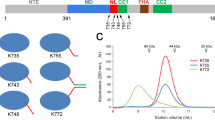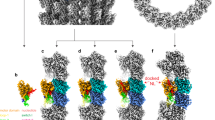Abstract
Mg-ADP release is considered to be a crucial process for the regulation and motility of kinesin. To gain insight into the structural basis of this process, we solved the atomic structures of kinesin superfamily protein-1A (KIF1A) during and after Mg2+ release. On the basis of new structural and mutagenesis data, we propose a model mechanism for microtubule activation of Mg-ADP release from KIF1A. In our model, a specific interaction between loop L7 of KIF1A and β-tubulin reconfigures the KIF1A active site by shifting the relative positions of switches I and II. This leads to the sequential release of a group of water molecules that sits over the Mg2+ in the active site, followed by Mg2+ and finally the ADP. We further propose that this set of events is linked to a strain-dependent docking of the neck linker to the motor core, which produces a two-step power stroke.
This is a preview of subscription content, access via your institution
Access options
Subscribe to this journal
Receive 12 print issues and online access
$259.00 per year
only $21.58 per issue
Buy this article
- Purchase on SpringerLink
- Instant access to full article PDF
Prices may be subject to local taxes which are calculated during checkout









Similar content being viewed by others
References
Hirokawa, N. & Takemura, R. Molecular motors and mechanisms of directional transport in neurons. Nat. Rev. Neurosci. 6, 201–214 (2005).
Endow, S.A. & Barker, D.S. Processive and nonprocessive models of kinesin movement. Annu. Rev. Physiol. 65, 161–175 (2003).
Cross, R.A. The kinetic mechanism of kinesin. Trends Biochem. Sci. 29, 301–309 (2004).
Block, S.M. Kinesin motor mechanics: binding, stepping, tracking, gating, and limping. Biophys. J. 92, 2986–2995 (2007).
Hirokawa, N. & Noda, Y. Intracellular transport and kinesin superfamily proteins, KIFs: structure, function, and dynamics. Physiol. Rev. 88, 1089–1118 (2008).
Hackney, D.D. Kinesin ATPase: rate-limiting ADP release. Proc. Natl. Acad. Sci. USA 85, 6314–6318 (1988).
Gilbert, S.P., Webb, M.R., Brune, M. & Johnson, K.A. Pathway of processive ATP hydrolysis by kinesin. Nature 373, 671–676 (1995).
Song, Y.H. & Mandelkow, E. Recombinant kinesin motor domain binds to β-tubulin and decorates microtubules with a B surface lattice. Proc. Natl. Acad. Sci. USA 90, 1671–1675 (1993).
Harrison, B.C. et al. Decoration of the microtubule surface by one kinesin head per tubulin heterodimer. Nature 362, 73–75 (1993).
Kuznetsov, S.A. & Gelfand, V.I. Bovine brain kinesin is a microtubule-activated ATPase. Proc. Natl. Acad. Sci. USA 83, 8530–8534 (1986).
Little, M. & Seehaus, T. Comparative analysis of tubulin sequences. Comp. Biochem. Physiol. B 90, 655–670 (1988).
Nogales, E. & Wang, H.W. Structural mechanisms underlying nucleotide-dependent self-assembly of tubulin and its relatives. Curr. Opin. Struct. Biol. 16, 221–229 (2006).
Hackney, D.D. Evidence for alternating head catalysis by kinesin during microtubule-stimulated ATP hydrolysis. Proc. Natl. Acad. Sci. USA 91, 6865–6869 (1994).
Schnitzer, M.J., Visscher, K. & Block, S.M. Force production by single kinesin motors. Nat. Cell Biol. 2, 718–723 (2000).
Okada, Y., Higuchi, H. & Hirokawa, N. Processivity of the single-headed kinesin KIF1A through biased binding to tubulin. Nature 424, 574–577 (2003).
Rosenfeld, S.S., Fordyce, P.M., Jefferson, G.M., King, P.H. & Block, S.M. Stepping and stretching. How kinesin uses internal strain to walk processively. J. Biol. Chem. 278, 18550–18556 (2003).
Klumpp, L.M., Hoenger, A. & Gilbert, S.P. Kinesin's second step. Proc. Natl. Acad. Sci. USA 101, 3444–3449 (2004).
Rice, S. et al. A structural change in the kinesin motor protein that drives motility. Nature 402, 778–784 (1999).
Vale, R.D. & Milligan, R.A. The way things move: looking under the hood of molecular motor proteins. Science 288, 88–95 (2000).
Vale, R.D. Switches, latches, and amplifiers: common themes of G proteins and molecular motors. J. Cell Biol. 135, 291–302 (1996).
Cheng, J.Q., Jiang, W. & Hackney, D.D. Interaction of mant-adenosine nucleotides and magnesium with kinesin. Biochemistry 37, 5288–5295 (1998).
Romani, A.M. & Scarpa, A. Regulation of cellular magnesium. Front. Biosci. 5, D720–D734 (2000).
Zhang, B., Zhang, Y., Wang, Z. & Zheng, Y. The role of Mg2+ cofactor in the guanine nucleotide exchange and GTP hydrolysis reactions of Rho family GTP-binding proteins. J. Biol. Chem. 275, 25299–25307 (2000).
Rosenfeld, S.S., Houdusse, A. & Sweeney, H.L. Magnesium regulates ADP dissociation from myosin V. J. Biol. Chem. 280, 6072–6079 (2005).
Vetter, I.R. & Wittinghofer, A. The guanine nucleotide-binding switch in three dimensions. Science 294, 1299–1304 (2001).
Erickson, J.W. & Cerione, R.A. Structural elements, mechanism, and evolutionary convergence of Rho protein-guanine nucleotide exchange factor complexes. Biochemistry 43, 837–842 (2004).
Rossman, K.L., Der, C.J. & Sondek, J. GEF means go: turning on RHO GTPases with guanine nucleotide-exchange factors. Nat. Rev. Mol. Cell Biol. 6, 167–180 (2005).
Muller, J., Marx, A., Sack, S., Song, Y.H. & Mandelkow, E. The structure of the nucleotide-binding site of kinesin. Biol. Chem. 380, 981–992 (1999).
Kikkawa, M. et al. Switch-based mechanism of kinesin motors. Nature 411, 439–445 (2001).
Nitta, R., Kikkawa, M., Okada, Y. & Hirokawa, N. KIF1A alternately uses two loops to bind microtubules. Science 305, 678–683 (2004).
Yun, M., Zhang, X., Park, C.G., Park, H.W. & Endow, S.A. A structural pathway for activation of the kinesin motor ATPase. EMBO J. 20, 2611–2618 (2001).
Sindelar, C.V. & Downing, K.H. The beginning of kinesin's force-generating cycle visualized at 9- resolution. J. Cell Biol. 177, 377–385 (2007).
Lowe, J., Li, H., Downing, K.H. & Nogales, E. Refined structure of αβ-tubulin at 3.5 Å resolution. J. Mol. Biol. 313, 1045–1057 (2001).
Kikkawa, M., Okada, Y. & Hirokawa, N. 15 Å resolution model of the monomeric kinesin motor, KIF1A. Cell 100, 241–252 (2000).
Kikkawa, M. & Hirokawa, N. High-resolution cryo-EM maps show the nucleotide binding pocket of KIF1A in open and closed conformations. EMBO J. 25, 4187–4194 (2006).
Ogawa, T., Nitta, R., Okada, Y. & Hirokawa, N. A common mechanism for microtubule destabilizers-M type kinesins stabilize curling of the protofilament using the class-specific neck and loops. Cell 116, 591–602 (2004).
Hirose, K., Akimaru, E., Akiba, T., Endow, S.A. & Amos, L.A. Large conformational changes in a kinesin motor catalyzed by interaction with microtubules. Mol. Cell 23, 913–923 (2006).
Hahlen, K. et al. Feedback of the kinesin-1 neck-linker position on the catalytic site. J. Biol. Chem. 281, 18868–18877 (2006).
Case, R.B., Rice, S., Hart, C.L., Ly, B. & Vale, R.D. Role of the kinesin neck linker and catalytic core in microtubule-based motility. Curr. Biol. 10, 157–160 (2000).
Hwang, W., Lang, M.J. & Karplus, M. Force generation in kinesin hinges on cover-neck bundle formation. Structure 16, 62–71 (2008).
Mazumdar, M. & Cross, R.A. Engineering a lever into the kinesin neck. J. Biol. Chem. 273, 29352–29359 (1998).
Kull, F.J. & Endow, S.A. Kinesin: switch I & II and the motor mechanism. J. Cell Sci. 115, 15–23 (2002).
Hancock, W.O. & Howard, J. Kinesin's processivity results from mechanical and chemical coordination between the ATP hydrolysis cycles of the two motor domains. Proc. Natl. Acad. Sci. USA 96, 13147–13152 (1999).
Crevel, I.M. et al. What kinesin does at roadblocks: the coordination mechanism for molecular walking. EMBO J. 23, 23–32 (2004).
Schief, W.R., Clark, R.H., Crevenna, A.H. & Howard, J. Inhibition of kinesin motility by ADP and phosphate supports a hand-over-hand mechanism. Proc. Natl. Acad. Sci. USA 101, 1183–1188 (2004).
Alonso, M.C. et al. An ATP gate controls tubulin binding by the tethered head of kinesin-1. Science 316, 120–123 (2007).
Otwinowski, Z. & Minor, W. Processing of X-ray diffraction data collected in oscillation mode. Methods Enzymol. 276, 307–326 (1997).
Brunger, A.T. et al. Crystallography & NMR system: a new software suite for macromolecular structure determination. Acta Crystallogr. D Biol. Crystallogr. 54, 905–921 (1998).
Okada, Y. & Hirokawa, N. A processive single-headed motor: kinesin superfamily protein KIF1A. Science 283, 1152–1157 (1999).
Patton, C., Thompson, S. & Epel, D. Some precautions in using chelators to buffer metals in biological solutions. Cell Calcium 35, 427–431 (2004).
Ma, Y.Z. & Taylor, E.W. Mechanism of microtubule kinesin ATPase. Biochemistry 34, 13242–13251 (1995).
Acknowledgements
We thank H. Fukuda, H. Sato and T. Akamatsu for assistance, and M. Kikkawa, H. Yajima, T. Ogawa, H. Ueno, H. Miki, E. Nitta and other colleagues for comments and technical assistance. This work was supported by a Center of Excellence Grant-in-Aid from the Ministry of Education, Culture, Sports, Science and Technology of Japan to N.H.
Author information
Authors and Affiliations
Corresponding author
Supplementary information
Supplementary Text and Figures
Supplementary Figures 1–4, Supplementary Tables 1 and 2 (PDF 2600 kb)
Supplementary Video 1
This movie supplements Figure 3. Ribbon models of the crucial proteinous elements for ADP/ATP exchange are shown. ADP, the Mg2+-stabilizer and the latch are shown as stick models. The Mg2+-water cap is shown as a ball model. Keys: Mg, cyan; H2O, red; P-loop, blue; L7, purple; switch I, green; switch II, yellow. (MOV 166 kb)
Supplementary Video 2
This movie supplements Figure 5. The main chains of the neck-linker, β0, and L13 are shown as sphere models. The side chains of conserved residues Val6 (blue), Leu285 (yellow), Asn322 (orange), Ile354 (red) and Asn361 (red) are also shown as sphere models. Key: β0, cyan; α4, yellow; α5-L13, light-orange; α6, brown; neck-linker, pink. (MOV 528 kb)
Rights and permissions
About this article
Cite this article
Nitta, R., Okada, Y. & Hirokawa, N. Structural model for strain-dependent microtubule activation of Mg-ADP release from kinesin. Nat Struct Mol Biol 15, 1067–1075 (2008). https://doi.org/10.1038/nsmb.1487
Received:
Accepted:
Published:
Issue date:
DOI: https://doi.org/10.1038/nsmb.1487
This article is cited by
-
A Model for Chemomechanical Coupling of Kinesin-3 Motor
Cellular and Molecular Bioengineering (2024)
-
Structural basis of mechano-chemical coupling by the mitotic kinesin KIF14
Nature Communications (2021)
-
A new structural arrangement in proteins involving lysine NH3 + group and carbonyl
Scientific Reports (2017)
-
The structural switch of nucleotide-free kinesin
Scientific Reports (2017)
-
Regulation of density of functional presynaptic terminals by local energy supply
Molecular Brain (2015)



